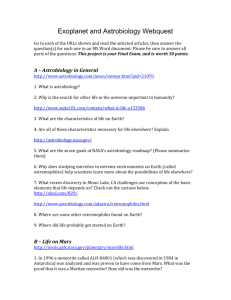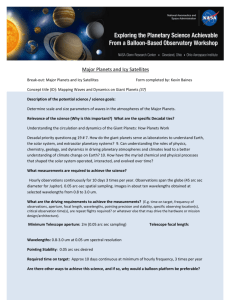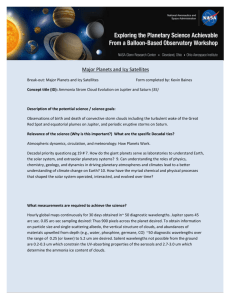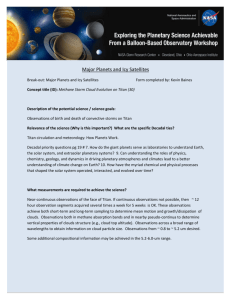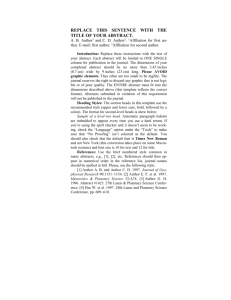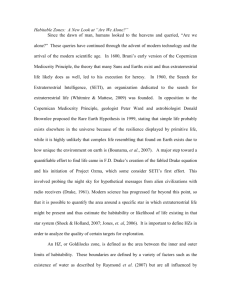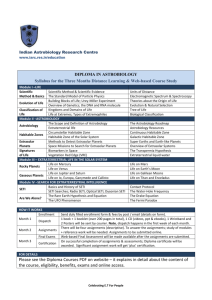Astrobiology Lecture Curse network (ABC Net)
advertisement
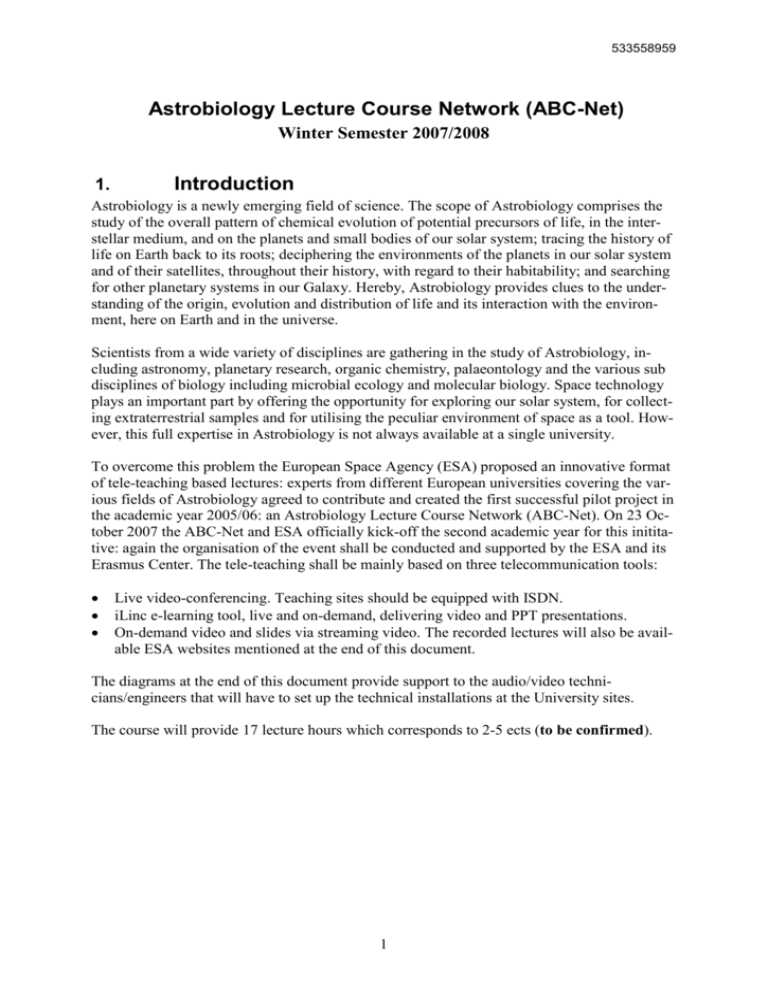
533558959 Astrobiology Lecture Course Network (ABC-Net) Winter Semester 2007/2008 1. Introduction Astrobiology is a newly emerging field of science. The scope of Astrobiology comprises the study of the overall pattern of chemical evolution of potential precursors of life, in the interstellar medium, and on the planets and small bodies of our solar system; tracing the history of life on Earth back to its roots; deciphering the environments of the planets in our solar system and of their satellites, throughout their history, with regard to their habitability; and searching for other planetary systems in our Galaxy. Hereby, Astrobiology provides clues to the understanding of the origin, evolution and distribution of life and its interaction with the environment, here on Earth and in the universe. Scientists from a wide variety of disciplines are gathering in the study of Astrobiology, including astronomy, planetary research, organic chemistry, palaeontology and the various sub disciplines of biology including microbial ecology and molecular biology. Space technology plays an important part by offering the opportunity for exploring our solar system, for collecting extraterrestrial samples and for utilising the peculiar environment of space as a tool. However, this full expertise in Astrobiology is not always available at a single university. To overcome this problem the European Space Agency (ESA) proposed an innovative format of tele-teaching based lectures: experts from different European universities covering the various fields of Astrobiology agreed to contribute and created the first successful pilot project in the academic year 2005/06: an Astrobiology Lecture Course Network (ABC-Net). On 23 October 2007 the ABC-Net and ESA officially kick-off the second academic year for this inititative: again the organisation of the event shall be conducted and supported by the ESA and its Erasmus Center. The tele-teaching shall be mainly based on three telecommunication tools: Live video-conferencing. Teaching sites should be equipped with ISDN. iLinc e-learning tool, live and on-demand, delivering video and PPT presentations. On-demand video and slides via streaming video. The recorded lectures will also be available ESA websites mentioned at the end of this document. The diagrams at the end of this document provide support to the audio/video technicians/engineers that will have to set up the technical installations at the University sites. The course will provide 17 lecture hours which corresponds to 2-5 ects (to be confirmed). 1 533558959 Figure 1. Location of the ABC-Net members 2 533558959 2. ABC-Net 2007/08 Lecture plan Each lecture starts Tuesdays at 14:00 (CET) and lasts for 60 min followed by a 15 min questions and answer period 2.1 Participating university, institution, lecturer and contact person: 1. ESA-ESTEC, Noordwijk, the Netherlands Lecturer: Jorge Vago, Rene Demets and Massimo Sabbatini, Contact person: Massimo Sabbatini, e-mail massimo.sabbatini@esa.int 2. Finland: University of Turku, Lecturer: Harry Lehto, Kirsi Lehto Contact person: Kirsi Lehto, e-mail klehto@utu.fi 3. France: University of Paris 12 & Paris 7, Lecturer: Francois Raulin, Herve Cottin, and Gabriel Tobie (University of Nantes) Contact person: Hervé Cottin, email cottin@lisa.univ-paris12.fr, Francois Raulin, e-mail raulin@lisa.univ-paris12.fr 4. Germany: Technical University of Dresden, Germany; Lecturer: Stefanos Fasoulas, Helga Stan-Lotter (University of Vienna), Heike Rauer (TU Berlin), and Petra Rettberg (DLR, Köln) Contact person: Tino Schmiel, e-mail tino.schmiel@tu-dresden.de 5. Germany: MPI Solar System Research with Universities of Braunschweig and Göttingen, Lecturer: Fred Goesmann Contact person: Dieter Schmitt e-mail schmitt@mps.mpg.de 6. Italy: University Tuscia, Viterbo, Lecturer: Raffaele Saladino Contact person: Raffaele Saladino, e-mail saladino@unitus.it 7. Italy: University of Napoli, Lecturer: A. Rotundi ( Contact person: John Robert Brucato, e-mail brucato@na.astro.it; 8. Poland: University of Szczecin, Lecturer: Ewa Szuszkiewicz, Franco Ferrari Contact person: Ewa Szuszkiewicz, e-mail szusz@univ.szczecin.pl 9. Portugal: New University of Lisbon, Contact person: M.E. Webb, e-mail: ew@fct.unl.pt 10. Russia, University of St. Petersburg Contact person: N. Gontareva, e-mail ngontar@mail.cytspb.rssi.ru 11. U.K. Open University, Milton Keynes, Lecturer: Charles Cockell, Monica Grady Contact person: Charles Cockell c.s.cockell@open.ac.uk and Tracey Ward: e-mail t.a.ward@open.ac.uk 12. Technical management: Massimo Sabbatini, ESA-ESTEC, Erasmus Centre, Directorate of Humanspaceflight, Microgravity and Exploration, e-mail: massimo.sabbatini@esa.int 13. Scientific coordinator: Gerda Horneck, DLR, Institute of Aerospace Medicine, Köln, Germany, gerda.horneck@dlr.de 3 533558959 Lecture No. Week Date 1 44 30.10.2007 2 45 3 Lecturer Institution Place of lecture Title A. Brack // H. Lehto University of Turku University of Turku Introduction (15 Min) // From Big Bang to the molecules of life (45 Min) 06.11.2007 E. Szcuszkiewicz University of Szcecin University of Szcecin Planet Formation 46 13.11.2007 H. Cottin University of Paris 12 CNES Paris Basic prebiotic chemistry 4 47 20.11.2007 K. Lehto University of Turku University of Turku From molecular evolution to cellular life 5 48 27.11.2007 R. Saladino University of Viterbo University of Viterbo Role of catalysis on synthesis of biomolecules 6 49 04.12.2007 F. Ferrari University of Szcecin University of Szcecin Hunting protein ancestors 7 50 11.12.2007 H. Stan-Lotter Univ. Salzburg University of Dresden Extremophiles, the physico-chemical limits of life (growth and survival) 8 51 18.12.2007 J. Vago/R. Demets/M. Sabbatini ESA/ESTEC ESA/ESTEC 9 3 15.01.2008 S. Fasoulas University of Dresden University of Dresden ESA Astrobiology missions and facilities within the HME directorate Astrodynamics and technology aspects of astrobiology missions in our solar system 10 4 22.01.2008 C. Cockell OU, Milton Keynes OU, Milton Keyes Habitability in our solar system and beyond 11 5 29.01.2008 M. Grady OU, Milton Keynes OU, Milton Keynes Astrobiology of terrestrial planets with emphasis on Mars 12 6 05.02.2008 G. Tobie University of Nantes CNES Paris Astrobiology of Jupiter's moon Europa 13 7 12.02.2008 F. Raulin CNES Paris Astrobiology of Saturn's moons Titan and Enceladus 14 8 19.02.2008 F. Goesmann University of Paris 12 University Braunschweig/Göttingen MPS Sonnenforschung Astrobiology of comets 15 9 26.02.2008 P. Rettberg DLR, Köln University of Dresden Planetary Protection Requirements 16 10 04.03.2008 H. Rauer Tu Berlin University of Dresden Exoplanets, detection and habitability 17 11 11.03.2008 A. Rotundi University of Napoli University of Napoli Methods for analysing cosmic dust 4 533558959 3. ABC-Net 2007/08 Abstracts Date 30/10/07 Lecturer A. Brack H. Lehto Place Title Univ Turku Short introduction into Astrobiology University of From Big Bang to the molecules of life Turku Abstract: Evolution of the universe predates both the chemical evolution and the evolution of life. We will summarise the origin of the critical elements for life, the CHNOPS, and the initial formation of molecules. From cosmological models we can understand the origin of hydrogen and helium. Later hydrogen will be required when water is formed. Helium, which appears quite useless for life, turns out to be a critical factor in the synthesis of carbon leading to heavier elements. The second compound of water, oxygen, is formed in the hot cores of stars. Once these elements get from the stars back into the cool interstellar space they begin forming interstellar clouds, where a vast spectrum of molecules is formed. The observed properties of these molecules, and the larger dust particles will be reviewed. These will the play an important role in the formation of planets in the accretion disks of a metal rich population of stars. This material reprocessed by the newly formed star and other planets “rains” on the young planet in the form of meteorites, comets and asteroids creating a supply of raw materials needed for the prebiotic evolution and the eventual biological evolution of life. 06/11/07 E. University Planet formation Szcuszkiewicz, of Szcecin Abstract: The most natural environment for the existence of life and its development is a planet orbiting a star. We have only one, but extremely good example for that, namely the planet Earth circling around the Sun. There are quite a few conditions which need to be satisfied for life to be present on our planet and this will be the subject of a separate lecture. Here, we would like to focus on the more basic question of how planetary systems form and evolve. We adopt a methodology which proved itself to be powerful and successful in the field of stellar evolution, which means, we make use of the fact that there are many stars with their planetary systems in the sky in different stages of their evolution. By observing them and building models we can reconstruct the time sequence and find out the most plausible scenarios for planet formation. Our methodology is justified, because we know already more than 200 mature, fully developed planetary systems and numerous examples of protoplanetary discs, which are believed to be the sites where planets are born. During this lecture we review the life history of our planetary system. We will admire how our present Solar System has been born, starting from the molecular cloud collapse, after passing through a deeply embedded protostellar phase and successively through a T Tauri phase. Next, we will watch how planetesimals and protoplanets form in protoplanetary discs via sedimentation and agglomeration until the final system arises after 4.6 mld years of its evolution. The Hubble Space Telescope, the Spitzer Space Telescope, the James Clerk Maxwell Telescope, among other missions and instruments, helped us to put together the different stages of this scenario. Advanced numerical simulations promise an even more detailed story, as they predict precisely the robust features in the structures of protoplanetary discs and the architectures of planetary systems. These predictions will be verified by present and future observatories like COROT (COnvection, ROtation and planetary Transits), Herschel, ALMA (Atacama Large Millimetre/Submillimetre Array), James Webb Space Telescope, Kepler and a few others. At the end of this lecture we consider briefly also what will happen with a planetary system, like our own, during further evolution of the central star, when the star enters a Red Giant phase and finally become a white dwarf. 13/11/07 H. Cottin University of Basic prebiotic chemistry 5 533558959 Paris 12 Abstract: Before life could arise on a planet, atoms have to organise themselves into complex biological molecules such as proteins, RNA, or DNA. Such elaborated structures can’t appear by themselves at once, they result from a complex chemical evolution, starting with the simplest organic compounds. At some point, at some yet to define stage of complexity and organisation of matter, an important step is made and chemistry turns into biology. This lecture is devoted to the study of prebiotic chemistry; it focuses on the very first steps of the chemical evolution: the synthesis of the building blocks of the molecular engine of any known living organism on Earth. In a previous lecture of this series, how atoms form in stars was explained. Now we consider how atoms can spontaneously combine to make molecules, before discussing the molecular evolution to cellular life in the next lecture. In the first part of this lecture living systems are dismantled into more elemental fragments: organic molecules. To address the origin of life, the next question would be how those fragments can be synthesized in an abiotic manner. After a short historical review about the chemistry of life different tracks are explored: an endogenous production of the molecules of life, within the Earth atmosphere or in the depths of primitive oceans, or an exogenous source of prebiotic molecules through space delivery via meteorites and comets. The chemical pathways of synthesis of the building blocks of life will then be described. 20/11/07 K. Lehto University of From molecular evolution to cellular life Turku Abstract: First, the essential features of cellular life will be considered; what is required for life, and what are the criteria of life. Nucleic acids, genetic code and its expression system are conserved and ubiquitous properties of all life forms, and therefore are assumed to be the most original functional units of life. Molecular analysis of these structures gives suggestions of how they may have been involved in the early molecular evolution, and what functions they may have provided to the early (precellular) replicators. By going backwards, step by step, one sees which inventions had to precede each stage of early evolution: genetically encoded proteins had to exist prior to the establishment of the Last Universal Common Ancestor (LUCA), and RNA-mediated RNA-replication, or so called RNA world, had to predate genetically encoded proteins. Some cellular RNA-molecules, which have different enzymatic activities and are highly conserved between different organisms are supposed to be relicts from this era. Still, many questions related to the early molecular evolution remain open. We do not know, for instance, the prebiotic synthesis routes for the nucleotides, how life chose to use the distinct nucleotides and amino acids in their distinct chiralic forms, how the first functional polynucleotides were assembled, or how the earliest life forms were confined. 27/11/07 R. Saladino University of Role of catalysis on synthesis of biomolecules Viterbo Abstract: Prebiotic chemistry plays a central role in the investigation of the possible scenarios of the early chemical environments. Its goal is to shed light on the events involved in the synthesis of initial biomolecules and on the self-organization processes that led the last common ancestor. Even though a well defined scenario for the physico-chemical conditions on the primitive Earth is not available, one can assume that a synthetic pathway, in order to be considered prebiotic, should use the simplest chemicals and the most common conditions present at that time. Low molecular weight molecules such as carbon dioxide, hydrogen cyanide, formamide and formaldehyde, easily formed from the primitive atmosphere by ultraviolet light, heat or electric discharge as energy sources, have been considered as prebiotic precursors. The catalysis played a crucial role in the prebiotic synthesis of biomolecules starting from these chemical precursors. Several minerals and metal oxides characterized by chemical, redox and photochemical catalytic properties were widely diffused on the primitive Earth. These compounds, when components of a reaction mixture, could have enhanced 6 533558959 the efficacy of prebiotic syntheses, affecting the selectivities of the reactions and furnishing local microenvironments able either to concentrate dilute reagents or to preserve newly formed biomolecules from degradative processes. In this lecture we will focus on the main concepts of catalysis applied to prebiotic chemistry, including homogeneous and heterogeneous catalysis, multifunctional catalysis and autocatalysis. Different examples on the role of catalysis in the synthesis of biomolecules starting from simple precursors will be discussed with a special attention to the synthesis of sugars, peptides and oligonucleotides. Examples of prebiotic synthesis of biomolecules with non terrestrial minerals as well as multicomponents catalysis will be also described. 04/12/07 F. Ferrari University of Hunting protein ancestors Szcecin Abstract: In searching the origin of life it is possible to apply two different approaches. The first one is a down-to-top approach, in which, starting from inanimated matter, like for instance basic organic compounds or aminoacids, one tries to reproduce the processes and the conditions that gave birth to the first living beings about 3.85 Ga ago. Alternatively, one may attempt to extract hints about the first steps of the evolution of life from the observation of present organisms. This top-down approach is based on the fact that all living forms have a common ancestor, so that it is licit to assume that some of its vestiges are still preserved inside the genetic code of current cells and bacteria. Indeed, it is well known that there are structures inside proteins, like structural motifs and folds, which seem to be intimately connected with evolution. For example, while there are about 100,000 expressed proteins in eukariotic systems, there are much fewer motifs and folds, a fact that is related to the pathways of evolution. In this lecture some aspects of the top-down approach will be illustrated. After a brief review of the known structures in proteins and other macromolecules which are relevant for life, a discussion will follow about the physical and chemical properties of biopolymers. Physical and chemical laws were in fact present during the period in which life started on the Earth and have certainly put constraints on the formation of the earliest biopolymers. Therefore, they can be exploited in order to guess how the genome of the most primitive organisms looked like. The information about the general characteristics of ancient life forms obtained using physical and chemical arguments may be used in the search of the remnants of the first genes which could be inside modern genes for instance due to processes of gene fusion. The lecture will end up with a discussion about the physical experimental methods that allow the detection of possible substructures inside biopolymers like proteins or DNA. 11/12/07 H. StanUniversity of Extremophiles, the physico-chemical limits of Lotter Dresden life (growth and survival) Abstract: Extreme environments are characterized by physical and chemical parameters which were considered lying outside the range which is suitable for life. In recent years, the notion of what constitutes life-limiting conditions in an environment has undergone dramatic changes: microorganisms and occasionally higher organisms were discovered, which not only tolerate, but thrive under ranges of temperatures, pH values, pressures, salinity, ionizing radiation etc. previously thought to destruct biomolecules and organisms. Some of the mechanisms responsible for these life styles are in the process of being elucidated. The presence of liquid water is a prerequisite for growth under all kinds of conditions; however, survival of resting stages, such as spores or dormant forms, was shown to occur in vacuum and in space conditions for several months. The detection of numerous viable prokaryotes and spores in subterranean locations, such as basalt, granite, ancient halite and sediments, suggests the possibility of extensive longevity, perhaps over millions of years. The implications of these discoveries for the search for extraterrestrial life are severalfold: the probability of finding prokaryotic life in environments such as the subsurface of Mars or the salty ocean of the Jovian moon Europa appears greatly enhanced, and the potential for panspermia is considered more plausible than ever before. 7 533558959 18/12/07 J. Vago & M. Sabbatini Abstract missing ESA/ESTEC ESA Astrobiology missions and facilities within the HME directorate 15/01/08 S. Fasoulas University of Astrodynamics and technology aspects of astroDresden biology missions in our solar system Abstract: Content: 1. Launch scenarios, Δv, launch windows, Constraints for biological payloads 2. Interplanetary trajectories Transfer trajectories, space environment, constraints for biological payloads 3. (Re)Entry, Descent, Landing Entry in different atmospheres (CO2, CH4, …), problems to biological payloads 4. Mission subsystems Energy system, Thermal system, Communication, Data Handling & Transfer, Interaction to biological payloads 5. Return-to-Earth Missions possibilities, technical constraints to probes, … Paragraph 1 to 5 shall be summarised for astrobiology missions to planets (Mars), asteroids, comets and/or moons (Europa) 22/01/08 C. Cockell OU, Milton Habitability in our solar system and beyond Keynes Abstract: What do we mean by ’habitability’ ? Habitability depends on the organisms that are considered and it is defined by the chemical and physical tolerances for a given organism. As we currently have no direct evidence for life on another planet, habitability is necessarily constrained by our knowledge of life on Earth. We use our knowledge of the extremes of life on Earth to assess extraterrestrial environments and the plausibility that they can support life. I will discuss the use and limitations of the concept of ’habitability’ and provide examples of how we assess the habitability of other worlds using organisms from extreme environments on Earth. I will discuss how considerations of energy availability (redox couples), the presence of water and carbon sources have shaped our view of the habitability of other planets and will eventually be used to assess the habitability of extrasolar planets. The formulation of a definition of ’habitability’ can greater assist us in defining the possibilities for life elsewhere. 29/01/08 M. Grady OU, Milton Keynes Astrobiology of terrestrial planets with emphasis on Mars Abstract missing University of Astrobiology of Jupiter’s moon Europa Paris 12 Abstract: The data returned by the Galileo spacecraft strongly suggest that a liquid 05/02/08 G. Tobie 8 533558959 water layer, several tens of kilometers thick, exist beneath the cold icy surface of Jupiter's moon Europa. This internal ocean would be in contact with the inner silicate core, possibly volcanically active. Interestingly, the (P,T) conditions at the silicate-ocean boundary are quite similar to those existing on the Earth's sea floor where organisms live without solar energy. The study of Europa is therefore essential to answer such as: does life exist everywhere water is present? Can life arise and develop in an environment where there is no sunlight ? What source of energy may be used by the microorganisms? The existence of an internal ocean is surprising since the satellite was expected to be frozen due to its very cold surface temperature (~100 K). For several years, tidal dissipation has been invoked to explain the possible presence of an ocean within Europa. Tidal dissipation comes from the viscoelastic response of the satellite to the 3.55-days tidal forcing. In the Laplace resonance, Io and Ganymede force the eccentricity of Europa. As it travels around Jupiter on an eccentric orbit, Europa is subjected to a periodical deformation. Due to the viscoelastic properties of its materials, viscous dissipation by shear friction occurs within each internal layer. Tidal dissipation in the inner core may heat up the outer silicate layer resulting in volcanism similar to the one observed on Io. Thermal evolution models indicate that the silicate core could have reached an highly dissipative state only if Europa experienced larger tidal forcing in the past. Future exploration of Europa is required to determine the exact depth of the liquid layer and to assess the possibility of seafloor silicate volcanism. The lecture reviews our present knownledge on Europa: its geology and its internal structure. Models of tidal dissipation and thermal evolution and their implications for the development of biogenic activity are presented. Concepts for future exploration missions toward Europa are summarized, with particular emphasis on the search for liquid water and on the exobiological potential of that "ocean" satellite. 12/02/08 F. Raulin University of Astrobiology of Saturn’s moons Titan and EncelParis 12 adus Abstract: Titan, largest satellite of Saturn, with a diameter of 5150 km, is the only satellite in the Solar System having a dense atmosphere. Since the discovery of the properties of this atmosphere, especially its main molecular composition – dinitrogen (N2) with a few percents of methane (CH4) – by the Voyager spacecraft observation in the early 80ties, Titan is considered as one of the most interesting bodies of the Solar System with regard to astrobiology. Indeed such an atmosphere is very favorable to the production of organic compounds as demonstrated by the Miller’s now historical experiment and the many similar experiments which were done later on. The likely presence of a complex organic chemistry in Titan’s atmosphere was also directly supported by the detection of many organic compounds detected by Voyager, and by several observations of Titan’s atmosphere from ground-based and Earth orbit telescopes. These discoveries were one of the main motivations of the scientific community for going back to the Saturn system with a very ambitious planetary mission: Cassini-Huygens. Most of our current knowledge of Titan is based on the new and very fresh observations done by Cassini-Huygens, coupled to laboratory experiments, including simulation experiments, and theoretical modeling (in particular photochemical models and ionospheric chemical models of the atmosphere, and models of the internal structure of the satellite). The lecture presents some historical data on Titan before Cassini-Huygens, before describing the Cassini-Huygens mission and its scientific payload. Then the models of formation and of internal structure of Titan are summarized and the general astrobiology of Titan is presented. Each of the three main astrobiological aspects - similarities with the Earth, organic chemistry and habitability – are described. Among the several fully unexpected discoveries done by the Cassini-Huygens mission are the observations of important geological activities on Enceladus, a smaller satellite of Saturn, with a radius of only 250 km. These observations and their potential astrobiological input are briefly described. New concepts for future exploration missions of Titan and Enceladus are presented as a conclusion. 9 533558959 19/02/08 F. Goesmann Abstract missing MPS Lindau Astrobiology of comets 26/02/08 P. University of Planetary Protection requirements Rettberg Dresden Abstract: ESA’s space exploration programme Aurora aims at the robotic and human exploration of the solar system with Mars, the Moon, Europa and the asteroids as the most likely targets. Mars is selected as the destination of the first Aurora Flagship mission ExoMars, followed by a Mars Sample Return mission. The scientific objectives of the ExoMars mission are the search for past and present life on Mars, the identification and characterization of possible hazards to future human exploration and the enhancement of our knowledge about the Martian environment in general. The reach these ambitious goals the importance of planetary protection measures becomes obvious. Planetary protection is the term that describes the aim of protecting solar system bodies (i.e. planets, moons, comets, and asteroids) from contamination by terrestrial life, and retroactive protecting Earth from possible life forms that may be returned from other solar system bodies. Planetary protection is necessary (i) to maintain the possibility to study these other solar system bodies in their pristine states, (ii) to avoid terrestrial contamination that would obscure the possibility to find indigenous life elsewhere and (iii) to ensure that the Earth's biosphere is protected from potential extraterrestrial sources of biological contamination. COSPAR, the Committee of Space Research, has formulated a planetary protection policy and defined planetary protection guidelines based on article IX of the UN Outer Space Treaty from 1967. The planetary protection procedures that have to be applied to a given spacecraft are determined by the type of mission (e.g. flyby, orbiter, lander, rover) and the biological interest posed by the spacecraft’s destination. Landers and rovers destined towards objects of high biological interest must undergo careful cleaning and sterilization. A Mars lander mission is classified as planetary protection category IVb/c with extremely low bioburden limits among other stringent requirements, if the landing is planned in a so called ‘special region’ with the potential for the existence of extant Martian life. All other landers on Mars are classified as category IVa with less stringent, but still technically challenging requirements concerning bioburden limits. In this lecture the planetary protection requirements, the bioburden limits and the principle methods and procedures to fulfill these requirements will be discussed in detail. 04/03/08 H. Rauer University of Exoplanets, detection and habitability Dresden Abstract: Since the mid-90’s the number of detected extrasolar planets around dwarf stars is rapidly increasing. Today, we know that our solar system is only one among many planetary systems of very different nature. Many of their characteristics know up to now came unexpected, questioned the traditional theories of planet formation. Nevertheless, our view of planetary systems is still very restricted. Mainly large giant planets have been found so far due to detection limits of the methods used. In the near future the already working space mission CoRoT (CNES) and the upcoming mission Kepler (NASA) are expected to find the first Earth-sized, terrestrial planets. Many of these terrestrial planets detected will probably be on short-period orbits or larger than Earth, forming to new classes of potentially habitable planets, so-called “hot-Earth” and “super-Earth”. However, under which conditions terrestrial extrasolar planets are providing habitable conditions still remains to be investigated. Habitability depends e.g. on the atmospheric composition and climate. Atmospheric models are used to predict the climatic conditions on different types of terrestrial planets and to predict the spectroscopic signatures of a potential biosphere. Such biospheric signals can be investigated by planned space missions like Darwin (ESA). The lecture will present the methods to 10 533558959 detect extrasolar planets, the main characteristics of the planets found so far and the expectations we have concerning habitable planets and the potential to detect biosignals in their atmosphere. 11/03/08 A. University of Methods of analysing cosmic dust Rotundi Napoli Abstract: Analysing extraterrestrial dust samples, i.e. Interplanetary Dust Particles (IDPs) and cometary dust collected in situ (Stardust samples), is critical to understand the role played by dust grains in driving the formation of complex molecular compounds relevant for the prebiotic chemistry occurred in the early Earth. In particular, one of the driving forces for cometary dust study is looking for confirmation of the historical theory, hypothesized by Halley, published by Newton in his Principia in 1686, and developed more or less continuously ever since that comets may have played an important role for the development of life on Earth. The extent to which comets enriched the primordial Earth with reactive C-bearing molecules and water is not known. The estimate of the endogenous contribution to Earth’s organic inventory during this period is in the order of 108-1010 kg year-1, while the flux of organic matter delivered to the Earth via comets and asteroids, averaged over the heavy bombardment period, may have been even larger at around 1011 kg year-1. Organic molecules have been detected in comets by comet fly-bys and by astronomical observations. The presence of C-bearing molecules in comets is to be expected based on numerous astronomical observations in which complex organic molecules have been detected, in dense molecular clouds and the diffuse interstellar medium. Dense clouds are known to contain mixed molecular ices. The radiation processing of these ices could produce a host of organic species, including some of astrobiological interest. Molecular clouds are the parent reservoirs of protoplanetary disks, like the solar nebula, where grains were further irradiated and the effects of which may be at least as important as those occurring in the diffuse Interstellar Medium (ISM). Organic molecules in comets could show a higher complexity than the diffuse ISM due to the reaction with fine grains of variable compositions such as ices and silicates as well as carbon grains and various molecules. Silicates act as catalysts for the reaction of organic molecules to higher complexity. The catalytic effects of cosmic dust analogues in prebiotic reactions have been studied in the laboratory at high temperatures and in conditions simulating the environments assumed for the early Earth. A large suite of complex organic molecules have been synthesized in the gas phase on the surface of cosmic silicate dust analogues. We will illustrate the methods of analysis and recent results obtained on cometary grains. The laboratory techniques that identify the C-rich entities present in the dust grains, provide information on their organic component, morphology, mineralogy and chemical composition. In particular, micro-Raman and micro-infrared spectroscopy, Field Emission Scanning Electron Microscopy and Energy Dispersive X-ray analyses have been applied on grains extracted from the Stardust aerogel cometary collector. The results of these analyses in terms of the nature of the organic matter present and a comparison of these findings with what is known about organic molecules in the ISM will be discussed. Following All All Examination 11 533558959 4. ABC-Net 2007/08 mailing list: André BRACK c.s.cockell@open.ac.uk fasoulas@tfd.mw.tu-dresden.de François Raulin gerda.horneck goesmann Grady Monica helga.stan-lotter Hervé COTTIN Harry lehto John Robert Brucato Jorge.Vago Kirsi Lehto Michel Viso Natalia Gontarova Petra Rettberg Rauer Heike rotundi Sabbatini Massimo Saladino Schmiel Tino Schmitt Dieter Szusz Tobie Gabriel Ward T.A Webb Maria brack@cnrs-orleans.fr c.s.cockell@open.ac.uk fasoulas@tfd.mw.tu-dresden.de raulin@lisa.univ-paris12.fr gerda.horneck@dlr.de goesmann@mps.mpg.de M.M.Grady@open.ac.uk helga.stan-lotter@sbg.ac.at cottin@lisa.univ-paris12.fr hlehto@utu.fi brucato@na.astro.it Jorge.Vago@esa.int klehto@utu.fi michel.viso@cnes.fr ngontar@mail.cytspb.rssi.ru petra.rettberg@dlr.de heike.rauer@dlr.de rotundi@uniparthenope.it massimo.sabbatini@esa.int saladino@unitus.it tino.schmiel@mailbox.tu-dresden.de schmitt@linmpi.mpg.de szusz@univ.szczecin.pl Gabriel.Tobie@univ-nantes.fr T.A.Ward@open.ac.uk ew@fct.unl.pt ESA-ESTEC video conferencing and iLinc points of contact: Melanie Cowan Jimmy Geogiades Master Control Room iLinc streaming video on demand Melanie.Cowan@esa.int jimmyg@parsecinfo.nl 0031 71 565 6322 isslinc.spaceflight.esa.int/virtual streamiss.spaceflight.esa.int 12 533558959 5. Connectivity Diagrams Figure 2: Connectivity Diagram 13 533558959 Figure 3: ilinc connectivity 14 533558959 Figure 4: VC and iLinc connectivity 15
